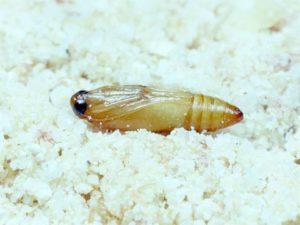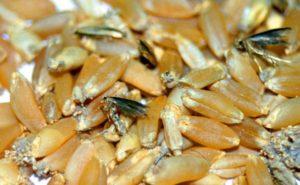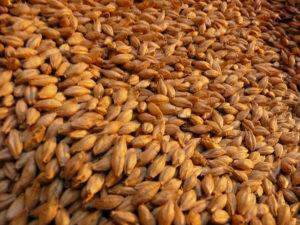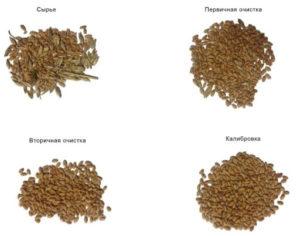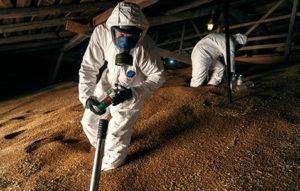Barn moth - a pest of tons of provisions
Content
Grain moth belongs to the group of pests of cereal crops. They are eaten not only by the grain worm, but also by its larvae. The insect destroys crops of wheat, rye, legumes.
What does grain moth look like (photo)
Description of the pest
Name: Barn Moth, Cereal or Bread
Latin: Nemapogon GranellaClass: Insects - Insecta
Squad: Lepidoptera - Lepidoptera
Family: Real moths - Tineidae
 | Habitats: | grain storage, house and apartment |
 | Dangerous for: | grain, crackers, dried mushrooms |
 | Means of destruction: | heat treatment, folk methods, chemicals |
White breadworm (grain moth) is a butterfly belonging to the family of moths, is a pest of grain stocks. It also destroys the following products:
- mushrooms;
- crackers;
- planting material.
The habitat of the pest is: granaries, residential buildings. The insect has the following appearance: the front pair of wings is gray in color with a few dark patches. The hind wings are brown with a small fringe, the wingspan is 14 mm.
The length of the caterpillar reaches 10 mm, the color is yellow, the head is brown. Within 12 months, 2 generations of the granary pest develop.
In the cold season, the parasite lives in a cocoon. Insects belonging to the 1st generation hatch in March. The female infects the grain by laying eggs.
How does this parasite appear?
Grain moth is a common type of crop pest. Inhabits grain warehouses, mills, flats, stacks and currents.
The development cycle of the pest has some peculiarity: the caterpillar grows imperceptibly, because it is inside the grain. Eggs are formed within 28 days. Sometimes their ripening period is 4 days and depends on the temperature regime. They tolerate low temperatures and high humidity. The hatched caterpillar is mobile and spends a lot of time on the surface of the grain.
In one seed of rye, 1 caterpillar settles, in corn grain their number reaches 2-3 individuals. The hole through which the pest entered the seed is stained with excrement.
The parasite destroys the mealy supply of cereals, forming a cavity filled with cobwebs. It divides the grain into 2 chambers: in the first there is a caterpillar, in the second - the products of its vital activity.
The caterpillar lives inside the grain until the end of its development. At an ambient temperature of +10…+12°C, the pest is in a state of hibernation, which lasts 5 months. The moisture content of the grain, necessary for the existence of the caterpillar, must be at least 15-16%.
How harmful and dangerous moth
The white breadworm is a pest that destroys wheat, barley, oats, rice, sorghum, legumes, etc. The grain moth damages peas only if the cereal is stored at a moisture content of 14%.
The pest destroys the surface layer of seeds to a depth of 20 cm. When the cereal is completely damaged by the grain moth, during the period of the emergence of butterflies, the temperature of the grain rises, areas of self-heating and caking are formed.
The first stage of damage to cereals is not detected immediately, because the inlet in the damaged grain is small.
The treatment of infected seeds does not always destroy the pest; it, along with the cereal, enters the granary. Soon the caterpillar turns into a chrysalis, from which a butterfly develops, laying eggs. The granary pest is in the warehouse until the stocks of grain run out.
Methods of struggle
To combat grain moth, the following methods are used:
- airing spoiled forage;
- grain heating up to +60°С;
- granary cleaning;
- the use of fumigants;
- the use of disinfected cereals;
- timely threshing of bread.
Grain is stored in special rooms protected from the penetration of rodents and birds. The cereals of the new crop are not mixed with last year's grain. Determine the degree of humidity of products, carry out cleaning in the storage.
The grain should not come into contact with the outer wall covering to prevent waterlogging, mold formation. It is necessary to monitor the indicators of temperature and humidity, taking into account the time of year.
If a barn moth is found in the room, carry out the following activities:
- process warehouses and storages with the help of chemicals;
- carry out mechanical cleaning;
- expose the grain to high temperatures;
- use fumigants to treat crops;
- disinfection with aerosols.
Stock cooling
There are 3 ways to store grain:
- dry;
- cooled;
- airless.
In farms, cereals are stored chilled. This method prevents the loss of crops, pests die. To cool the products, exhaust ventilation is used, which works around the clock.
Cooling the grain preserves the new crop. The temperature range is from 0 to +12°. In this case, a slight decrease in the weight of the cereal is observed, amounting to 0,1%.
Pests degrade the quality of the product. If the grain temperature is less than +19°C, the activity of the grain moth increases. Harvest safety is ensured by a temperature of + 12 ° C and humidity - 18%.
Grain heating
In order to preserve the grain, it is subjected to processing, which is carried out in elevators. Use special dryers. For each culture determine the temperature regime.
Before heating the forage, it must be cleaned. The moth dies at a temperature of +55°C, the treatment lasts from 10 minutes to 2 hours.
The seed material is not heated, because the pests do not die. To achieve a 100% result, two-stage heating is used. Dry grain is dipped into the dryer twice and then checked for pests.
Grain cleaning
The grain moth is removed using the method of separating one batch of product from another. Separation allows you to destroy the grain moth, which is located in the space between the seeds. This method is not used if it is necessary to process infected grain, inside of which there is a pest.
Infected cereals are cleaned using special machines with aspiration systems that prevent the spread of harmful substances into the environment. They destroy moths in winter, while cooling the grain.
They do not control the granary pest in the summer months, as this leads to its further spread.
Chemical methods of destruction
Finished preparations are used to disinfect mills, elevators, feed grains, cereals and flour. If the warehouse is not filled with products, fumigants and aerosol preparations are used.
In the room where the barn moth lives, pest control agents are used. Before starting work, one should take into account not only the type of pest, but also the type of building, its proximity to administrative buildings, farms, etc.
Empty rooms are treated with fumigants, leaving bags, inventory, and equipment in the warehouse. The work is carried out before the start of loading a new crop, taking into account the air temperature.
At +12°C, the granary worm is in an active state. Sprayers are used for wet chemical cleaning. The grain moth dies upon contact with a disinfectant liquid.
Wet processing
Grain moth larvae and their eggs can be removed by wet processing. It is necessary to add 1 tsp to the water. 0,9% table vinegar. The container in which the grain was stored is washed or left for disinfection in the freezer. Wet cleaning is carried out using washing equipment, adding various chemicals to the water.

The fight against moths should be carried out comprehensively.
Folk remedies
At home, the pest can be destroyed by drying the cereal in the oven at a temperature of + 60 ° C for 2 hours. On an industrial scale, grain dryers are used. A low temperature is created in the room by opening windows in winter, or containers with infected cereals are taken out to the balcony. Stocks of cereals are sometimes cooled in the refrigerator.
A combination of different ways
Before choosing a method of combating a grain pest, the degree of loss should be determined. Applying several methods of struggle, you can achieve success. It is necessary to destroy the stock of spoiled cereals, carry out wet cleaning, set traps for single parasites.

Grain storage.
Preventive measures
To preserve grain, the following measures are taken: they comply with sanitary standards, take measures to prevent the development of moths, use modern buildings for storing grain, use ventilation devices, and maintain a low temperature.
